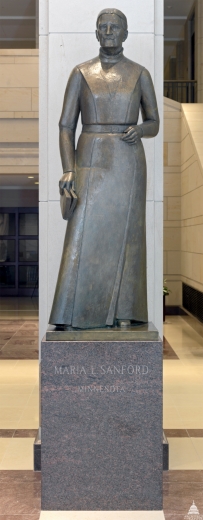
Explore Capitol Hill
Bronze
Given by Minnesota in 1958
Emancipation Hall
U.S. Capitol Visitor Center
This statue of Maria Sanford was given to the National Statuary Hall Collection by Minnesota in 1958.
Maria Sanford was born in Saybrook, Connecticut, on December 19, 1836. Her love for education began early; at the age of 16 she was already teaching in county day schools. She graduated from Connecticut Normal School, using her dowry funds for tuition. She rose in the ranks of local and national educators, becoming principal and superintendent of schools in Chester County, Pennsylvania, and serving as professor of history at Swarthmore College from 1871 to 1880. She was one of the first women named to a college professorship. When the University of Minnesota asked her to join its faculty, she did so enthusiastically.
During her tenure at the university (1880-1909) Sanford was a professor of rhetoric and elocution, and she lectured on literature and art history. She was a champion of women's rights, supported the education of blacks, pioneered the concept of adult education, and became a founder of parent-teacher organizations. Sanford was also a leader in the conservation and beautification program of her new state. She traveled throughout the United States delivering more than 1,000 patriotic speeches, the most famous being the powerful address "An Apostrophe to the Flag," that she delivered at a national Daughters of the American Revolution convention.
She died on April 21, 1920, at the age of 83. In June of that year the University of Minnesota held a memorial convocation in her honor. She was called "the best loved woman of the North Star State."







